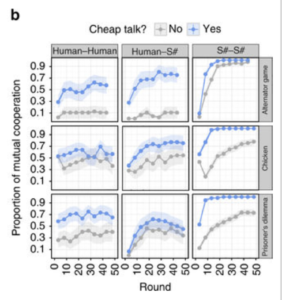By Dr. Ken Broda Bahm:
 Could artificial intelligence settle your case? In other words, could a smart computer algorithm separate out the emotions, compare the interests, and distill the positions down to their best logical resolution? Maybe not immediately, but the question is not as silly as it might seem. Artificial intelligence is already making inroads in law, as laid out in a a new book, “Robots in Law: How Artificial Intelligence is Transforming Legal Services.” Of course, you might understandably think that it is one thing to flexibly generate contracts and wills, and another to handle the human nuance of an extended negotiation. But even there, an algorithm has some advantages, conceivably even over humans. Anyone who has sat through a tense and frustrating negotiation might see the benefit in a digital rather than emotional positioning. And ultimately, is it really much worse than putting it in the hands of a mediator?
Could artificial intelligence settle your case? In other words, could a smart computer algorithm separate out the emotions, compare the interests, and distill the positions down to their best logical resolution? Maybe not immediately, but the question is not as silly as it might seem. Artificial intelligence is already making inroads in law, as laid out in a a new book, “Robots in Law: How Artificial Intelligence is Transforming Legal Services.” Of course, you might understandably think that it is one thing to flexibly generate contracts and wills, and another to handle the human nuance of an extended negotiation. But even there, an algorithm has some advantages, conceivably even over humans. Anyone who has sat through a tense and frustrating negotiation might see the benefit in a digital rather than emotional positioning. And ultimately, is it really much worse than putting it in the hands of a mediator?
A recent study suggests that, not only is AI-negotiation realistic, it is also in some ways better than human negations. The study (Crandall et al., 2017) was conducted by BYU computer science professors with colleagues at MIT and other international universities. Instead of testing artificial intelligence by having it compete against humans, in a ‘Deep Blue’-style chess match for example, the team focused on the ability of artificial intelligence to cooperate with people in situations where the interests of the parties are not fully aligned, nor fully in conflict. Using 220 (human) participants and a total of 472 repeated games, the team tested a number of different algorithms in negotiation games conducted through a computer interface that hid the adversary’s identity. Some negotiations were human to human, some were machine to human, and some were machine to machine. What they found is that one algorithm, S# (pronounced “S-sharp”) promoted cooperation at least as well and, in some ways, better than humans.
But one kicker is that the algorithm only clearly bested humans when it incorporated one distinctly human feature. That feature is what the negotiation experts call “cheap talk,” or words that amount to mere sharing, and do not bind the parties or cost them in terms of negotiating posture. The chart below shows repeated rounds of negotiations (horizontal axis) in three different types of negotiations (right-hand vertical), and the resulting amount of cooperation (left-hand vertical). As indicated, the blue line (for cheap talk) results in a marked improvement.

There are also two other interesting take-aways from the research.
The Human Element Makes Cooperation More Difficult
The logic of negotiations is complex enough. Add in the emotional and relational components and it can be overwhelming. This is where a machine can have an advantage. Lead author, Jacob Crandall, explained in a ScienceDaily release, “Two humans, if they were honest with each other and loyal, would have done as well as two machines,” he said. “As it is, about half of the humans lied at some point.” The algorithm, programmed not to lie, actually ended up being more moral and more reliable.
An additional way the AI did better was in maintaining cooperation after it emerges. Once cooperation was established, the S# algorithm would not deviate from cooperation, but often human negotiators would and, almost always, these deviations led to reduced payoffs to that party. That is one reason why the winner in all three of the scenarios tested was the machine to machine pairing.
Professor Crandall continues, “In society, relationships break down all the time,” he said. “People that were friends for years all of a sudden become enemies. Because the machine is often actually better at reaching these compromises than we are, it can potentially teach us how to do this better.”
But Human Factors Can Also Help
Interestingly, in the early parts of the study, they tested a broad array of algorithms and found that many in common use turned out to be ineffective in negotiations. For example, what are called “generalized tit-for-tat algorithms” (which we can certainly picture in settlement talks) were ineffective for longer negotiations because they did not adapt.
Indeed, even the best performing algorithm was not particularly effective until the researchers added the feature of “cheap talk,” or “costless non-binding signals.” Having the computer reply with lines like, “Sweet. We are getting rich!” in response to agreement or more trash-talking lines like “In your face!” or “You will pay for that!” in response to disagreement helped to build the relationship. You probably wouldn’t say the same things in negotiations, but you should include talk that serves a relational and not just a logical function.
“These signaling capabilities expand S#’s flexibility in that they also allow S# to more consistently forge cooperative relationships with people,” the authors note. “Without this capability, it does not consistently do so.”
There’s an important message there. If the only thing you are communicating is positions and moves, then you are not building a relationship, and that lack of a relationship will place a substantive limit on your ability to achieve a good result in negotiations.
Other Posts on Settlement Negotiations:
- Break Through the Barriers: The Settlement Series, Part One
- When You Press the Negotiations, Pause the Persuasion
- Cooperate
Crandall, J. W., Oudah, M., Ishowo-Oloko, F., Abdallah, S., Bonnefon, J. F., Cebrian, M., Shariff, A., Goodrich, M.A. & Rahwan, I. (2017). Cooperating with Machines. arXiv preprint arXiv:1703.06207.